The dry bulk shipping market has recently seen a temporary surge in the Panamax sector, but the long-term stability of the smaller Supramax, Ultramax, and Handysize segments is proving to be more resilient, thanks to a steady flow of specific cargoes. While top-down rallies can provide a short-term boost, the foundation of the market’s strength lies in consistent, reliable shipments of goods that are exclusive to these smaller vessels.
The Unreliable Nature of Rally Spillovers
In mid-July, the Panamax sector experienced a significant rally, driven by tightening tonnage in the transatlantic route and speculation about new trade policies. This upward momentum briefly spilled over to smaller ships, particularly on routes for US coal and corn. However, this strength proved to be short-lived, with momentum evaporating as soon as the Panamax rates corrected, underscoring the point that such temporary spikes cannot be a sustainable source of market strength.
The Steady Support of Geared Tonnage
The resilience of the Supramax, Ultramax, and Handysize segments is attributed to cargoes like petroleum coke, cement, and clinker. These commodities are not only exclusive to these geared bulkers but also provide vital cargo diversification, which is especially important given global geopolitical risks and structural shifts in manufacturing and infrastructure.
The Role of Petcoke in the Dry Bulk Market
Petroleum coke (petcoke), a byproduct of oil refining, makes up a significant portion of ton-miles for geared bulkers, particularly for US exports. Despite its carbon-intensive nature, its use has rebounded since 2022 due to the Russia-Ukraine war and its price competitiveness compared to other fuels. The US remains the world’s top exporter, and global exports are showing a steady increase. However, the petcoke trade is facing volatility due to shifting demand and trade tensions. While traditional buyers like Japan and Mexico have scaled back, new importers like India, China, and Brazil have emerged. Trade conflicts, such as China’s 37% tariff on US petcoke and potential new US tariffs on India, could disrupt these trade routes. Nevertheless, a certain type of petcoke, calcined petcoke, remains in high demand for anode production in growing industries like electric vehicles and solar manufacturing, providing a stable source of demand.
The Foundation of Cement and Clinker
Cement and clinker, a key component in cement production, are described as the “silent workhorses” of global development. Their demand is fueled by worldwide public infrastructure spending, from data centers in the US to new roads in developing nations. The US was the top global importer of cement in 2024. Türkiye is the world’s largest exporter of cement and is on track to surpass its 2024 export volume. Vietnam, another major clinker exporter, is also seeing a rebound in its exports after a tax cut. These consistent, infrastructure-driven cargoes provide a stable and vital source of business for the smaller dry bulk segments.
Did you subscribe to our daily Newsletter?
It’s Free Click here to Subscribe!
Source: Breakwave Advisors
























